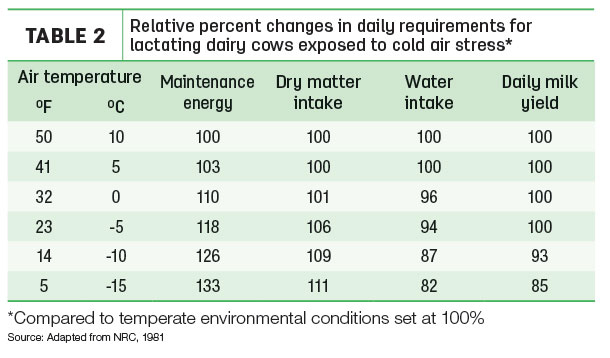While striving to produce a high milk output, the lactating dairy cow partitions a portion of the energy consumed each day to maintain a normal body temperature at 101ºF. However, when it gets cold, cows use more energy for maintenance to help keep warm. Cows naturally can withstand cold weather by growing a thick and dense winter coat, but that takes time. Housing type and environment do play a factor, say for example comparing a housed freestall with curtains situation to an open corral.
Lower critical temperature
The temperature at which the mature lactating dairy cow responds to cold stress is called the lower critical temperature (LCT). Much of the LCT research historically had been adapted from the beef cow industry, but it gives some good biological reference points. The LCT for cows exposed to still air cold (no wind chill) depends on their coat condition and is summarized in Table 1.

The mature cow’s winter coat provides insulation for it to withstand more challenging still air LCTs before diverting energy from milk production to keeping warm. However, for dairy cows not in a curtained freestall environment, the exposure to high winds will have a wind chill effect, and that can drastically change her LCT. For example, at 32ºF and a sustained winter wind speed of 10 miles per hour (mph), it will feel to the cow like 18ºF. The cow will increase its energy use to maintain body temperature accordingly, with less available for milk production.
Dairy cow responses to cold stress
Based on studies and data published in 1981, we have a better understanding on the type of responses lactating dairy cows will exhibit when challenged with cold stress. This is summarized in Table 2.

A few interesting biological changes occur:
- As still air temperatures fall to freezing or below, a cow’s maintenance energy requirements increase by 10% or more to help maintain body temperature. Wind chill would make this scenario worse and require more energy.
- Below freezing, dry matter appetite will improve, generally by 5% to 10% in an attempt to “eat more” ration energy.
- Water intakes will decline with cold water.
- With a change in energy partitioning and potential lower water intakes, eventually average milk yield can decline.
- Remarkably, the modern dairy cow will continue to maintain milk yield, even with still air temperatures around 20ºF. Practical experience suggests body condition will be lost to maintain body heat and milk yield.
Managing for high performance during cold stress
This will need a team approach from both the farm and the nutritional consultant. A few areas to monitor:
-
Forage inventories: Have a good handle on the ensiled forage dry matter content on a regular and frequent basis. This ensures there are no surprises on forage-to-grain ratios.
-
Refusals: Similarly think about cow pen numbers, how cold weather changes intakes and how much total mixed ration (TMR) refusal to allow. When it gets cold, cows can ramp up dry matter intakes (DMIs) higher than some normal refusal allowances. Avoid cows running out of feed at the feedbunk and allow higher TMR refusals for the transition cow pens.
-
Body condition scores: With prolonged cold spells and the herd is holding production, watch body condition scores and milk protein content. A reduction in either one or both is a sign more energy is needed in the ration. This can be met with extra grain inclusion or bypass fat. The fresh cow pen will be particularly susceptible to prolonged cold-weather challenges, undergoing so many changes during those first few days of lactation; ensure DMI is high and include feed additives to support the immune system.
-
Equipment: Safely inspect the mixer on a regular basis, and repair and maintain as needed. Solid ice chunks can get into the mixer wagon and cause damage to knives or other internal working parts. Keep an eye on the TMR quality and consistency during feedout. Also, watch out for any extraneous metal on the feedout tray magnet.
-
Feed additives: With the many ration changes inherent during winter, plus the cows’ intake and potential ration digestibility challenges, it’s prudent to include a proven, rumen-specific active dry yeast at all stages of lactation to lower risk of SARA, enhance ration digestibility, maintain rumen function and intake levels.
-
Water temperature: Ensuring proper water intake is important to milk yield. In addition to monitoring for frozen troughs and other drinking points, make sure water refresh rates are to expectations. Also, cows that receive warm water is a real bonus to keep intake levels high.
- Winter coat: A cow’s winter coat serves it best when kept clean and dry. Good, clean, dry bedding is a must, and cow grooming brushes are a useful bonus.
As we end this year, let’s avoid “a winter of discontent” and keep ahead of the cows’ changing appetites and need for extra energy to help maintain production and body score. With a few minor adjustments to the ration and feeding protocols, lactating dairy cows can keep producing efficiently and keep “Jack Frost” at bay. ![]()
PHOTO: Mike Dixon.
Tony Hall received his master’s in animal science from Aberdeen University in Scotland and is employed by Lallemand Animal Nutrition, North America as a technical services – ruminant team member.
References omitted but are available upon request.

-
Tony Hall
- Technical Services – Ruminant
- Lallemand Animal Nutrition, North America
- Email Tony Hall




